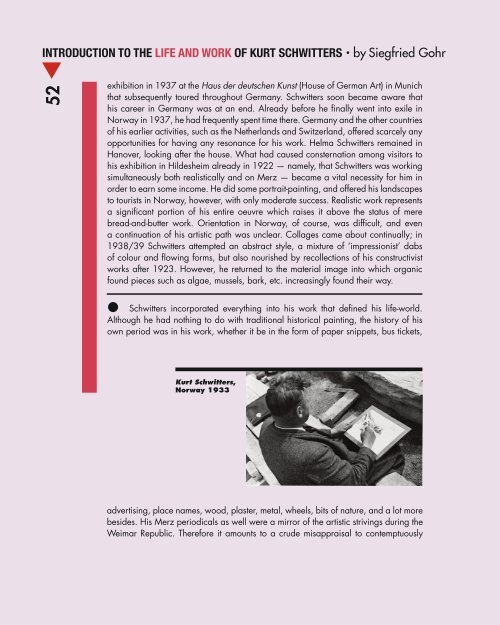Kurt Schwitters: Merz (2016) – Norman Rosenthal interviews Damien Hirst
Fully illustrated catalog published by Galerie Gmurzynska in collaboration with Cabaret Voltaire Zurich on the occasion of Kurt Schwitters: MERZ, a major retrospective exhibition celebrating 100 years of Dada. The exhibition builds and expands on the gallery’s five decade long exhibition history with the artist, featuring exhibition architecture by Zaha Hadid. Edited by Krystyna Gmurzynska and Mathias Rastorfer. First of three planned volumes containing original writings by Kurt Schwitters, historical essays by Ernst Schwitters, Ad Reinhardt and Werner Schmalenbach as well as text contributions by Siegfried Gohr, Adrian Notz, Jonathan Fineberg, Karin Orchard, and Flavin Judd. Foreword by Krystyna Gmurzynska and Mathias Rastorfer. Interview with Damien Hirst conducted by Norman Rosenthal. Includes full color plates and archival photographs. 174 pages, color and b/w illustrations. English. ISBN: 978-3-905792-33-1 The publication includes an Interview with Damien Hirst by Sir Norman Rosenthal about the importance of Kurt Schwitters's practice for Hirst's work.
Fully illustrated catalog published by Galerie Gmurzynska in collaboration with Cabaret Voltaire Zurich on the occasion of Kurt Schwitters: MERZ, a major retrospective exhibition celebrating 100 years of Dada. The exhibition builds and expands on the gallery’s five decade long exhibition history with the artist, featuring exhibition architecture by Zaha Hadid.
Edited by Krystyna Gmurzynska and Mathias Rastorfer.
First of three planned volumes containing original writings by Kurt Schwitters, historical essays by Ernst Schwitters, Ad Reinhardt and Werner Schmalenbach as well as text contributions by Siegfried Gohr, Adrian Notz, Jonathan Fineberg, Karin Orchard, and Flavin Judd.
Foreword by Krystyna Gmurzynska and Mathias Rastorfer.
Interview with Damien Hirst conducted by Norman Rosenthal.
Includes full color plates and archival photographs.
174 pages, color and b/w illustrations.
English.
ISBN:
978-3-905792-33-1
The publication includes an Interview with Damien Hirst by Sir Norman Rosenthal about the importance of Kurt Schwitters's practice for Hirst's work.
You also want an ePaper? Increase the reach of your titles
YUMPU automatically turns print PDFs into web optimized ePapers that Google loves.
INTRODUCTION TO THE LIFE AND WORK OF KURT SCHWITTERS · by Siegfried Gohr<br />
t<br />
52<br />
exhibition in 1937 at the Haus der deutschen Kunst (House of German Art) in Munich<br />
that subsequently toured throughout Germany. <strong>Schwitters</strong> soon became aware that<br />
his career in Germany was at an end. Already before he finally went into exile in<br />
Norway in 1937, he had frequently spent time there. Germany and the other countries<br />
of his earlier activities, such as the Netherlands and Switzerland, offered scarcely any<br />
opportunities for having any resonance for his work. Helma <strong>Schwitters</strong> remained in<br />
Hanover, looking after the house. What had caused consternation among visitors to<br />
his exhibition in Hildesheim already in 1922 — namely, that <strong>Schwitters</strong> was working<br />
simultaneously both realistically and on <strong>Merz</strong> — became a vital necessity for him in<br />
order to earn some income. He did some portrait-painting, and offered his landscapes<br />
to tourists in Norway, however, with only moderate success. Realistic work represents<br />
a significant portion of his entire oeuvre which raises it above the status of mere<br />
bread-and-butter work. Orientation in Norway, of course, was difficult, and even<br />
a continuation of his artistic path was unclear. Collages came about continually; in<br />
1938/39 <strong>Schwitters</strong> attempted an abstract style, a mixture of ‘impressionist’ dabs<br />
of colour and flowing forms, but also nourished by recollections of his constructivist<br />
works after 1923. However, he returned to the material image into which organic<br />
found pieces such as algae, mussels, bark, etc. increasingly found their way.<br />
•<br />
<strong>Schwitters</strong> incorporated everything into his work that defined his life-world.<br />
Although he had nothing to do with traditional historical painting, the history of his<br />
own period was in his work, whether it be in the form of paper snippets, bus tickets,<br />
<strong>Kurt</strong> <strong>Schwitters</strong>,<br />
Norway 1933<br />
advertising, place names, wood, plaster, metal, wheels, bits of nature, and a lot more<br />
besides. His <strong>Merz</strong> periodicals as well were a mirror of the artistic strivings during the<br />
Weimar Republic. Therefore it amounts to a crude misappraisal to contemptuously

















